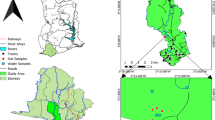Abstract
Great concern has been raised with respect to the 13 traplines that constitute the traditional territory of the Ouje-Bougoumou Cree located in the James Bay region of northern Quebec, Canada, with respect to mine wastes originating from three local mines. As a result, an “Integrative Risk Assessment” was initiated consisting of three interrelated components: a comprehensive human health study, an assessment of the existing ecological/environmental database, and a land use/potential sites of concern study. In this paper, we document past and present land use in the traditional territory of the Ouje-Bougoumou Cree for 72 heads of households, including 13 tallymen, and use a Geographic Information System (GIS) to layer harvest/hunting and gathering/collecting data over known mining areas and potential sites of concern. In this way, potential receptors of contamination and routes of human exposure were identified. Areas of overlap with respect to land use activity and mining operations were relatively extensive for certain harvesting activities (e.g., beaver, Castor canadensis and various species of game birds), less so for fish harvesting (all species) and water collection, and relatively restrictive for large mammal harvesting and collection of firewood (and other collection activities). Potential receptors of contaminants associated with mining activity (e.g., fish and small mammals) and potential routes of exposure (e.g., ingestion of contaminated game and drinking of contaminated water) were identified.
Similar content being viewed by others
References
Anonymous. (1976). Fieldwork methodology: rational and assessment. In: Inuit land use and occupancy project, Volume 2: supporting documents (pp. 47–59). Ottawa, Canada: Milton Freeman Research Limited, Thorn Press Limited.
Anonymous. (2002). Integrated risk assessment: A response to the metal contamination within the Ouje-Bougoumou Cree traditional territory. Quebec, Canada: Cree Nation of Ouje-Bougoumou, Ouje-Bougoumou.
Campbell, P. (2005). Integrated Risk Assessment: A response to the metal contamination within the Ouje-Bougoumou Cree traditional territory. Quebec City, Quebec: INRS Eau Terre et Environnement.
CL COVEL PG LLC. (2001). Sediment, surface water and fish quality investigation Ouje-Bougoumou Cree Nation territory Quebec, Canada. New Hampshire, USA: C.L. Covel & R.D. Master.
Dewailly, E., Nantel, A., & Mayotte, P. (2001). Preliminary reaction to the document titled: Sediment, surface water and fish quality investigation, Ouje-Bougoumou Cree Nation territory, Quebec, Canada. Quebec, Canada: Quebec Public Health Institute.
Dewailly, E., Nieboer, E., Ayotte, P., Levallois, P., Nantel, A.J., Tsuji, L.J.S., Wainman, B.C., & Weber, J. P. (2003). Exposure and preliminary health assessments of the Ouje-Bougoumou Cree population to mine tailings residues, draft report of the survey. Quebec City, Quebec, Canada: Institut National de Sante Publique du Quebec.
Dewailly, E., Nieboer, E., Ayotte, P., Levallois, P., Nantel, A.J., Tsuji, L.J.S., Wainman, B.C., & Weber, J. P. (2005). Exposure and preliminary health assessments of the Ouje-Bougoumou Cree population to mine tailings residues. Quebec City, Quebec: Institut National de Sante Publique du Quebec.
Environmental Sciences Group (ESG). (1999a). Mid-Canada Line 1998 Site Assessment/Delineation. Kingston, Ontario, Canada: Royal Military College, Environmental Sciences Group.
Environmental Sciences Group (ESG). (1999b). Fort Albany, Site (050). Site remediation phase one: Delineation 1999. Kingston, Ontario, Canada: Royal Military College, Environmental Sciences Group.
Feit, H.A. (1973). The ethno-ecology of the Waswanipi Cree; or how hunters can manage their resources. In: B. Cox (ed), Cultural ecology: readings on Canadian Indians and Eskimos (pp. 115–125). Toronto, Ontario, Canada: McClelland and Stewart Limited.
Feit, H.A. (1982). The future of hunters within nation-states: anthropology and the James Bay Cree. In: E. Leacock & R. Lee (eds.), Politics and history in band societies (pp. 373–411). Cambridge, UK: Cambridge University Press.
Feit, H.A. (1986). James Bay Cree Indian management and moral considerations of fur-bearers. In: The 1986 symposium of the Alberta Society of Professional Biologists, Native people and renewable resource management (pp. 49–65). Edmonton, Alberta, Canada: Alberta Society of Professional Biologists.
Feit, H.A. (1987). Waswanipi Cree management of land and wildlife: Cree ethno-ecology revisited. In: B.A. Cox (ed.), Native people, Native lands: Canadian Indians, Inuit and Metis (pp. 75–91). Ottawa, Canada: Carlton University Press.
Feit, H.A. (1989). James Bay Cree self-governance and land management. In: E.N. Wilmsen (ed.), We are here, politics of aboriginal land tenure (pp. 68–98). Los Angeles: University of California Press.
Feit, H.A. (1991). Gifts of the land: hunting territories, guaranteed incomes and the construction of social relations in James Bay Cree society. Senri Ethnological Studies, 30, 223–268.
Frenette, J. (1985). The history of the Chibougamau Cree. Quebec, Canada: Canada Cree Indian Centre of Chibougamau, Chibougamau.
Hedican, E.J. (1995). Applied anthropology in Canada, Understanding aboriginal issues. Toronto, Ontario, Canada: University of Toronto Press.
Hrenchuk, C. (1993). Native land use and common property. In: (eds), Traditional ecological knowledge: Concepts and cases (pp. 69–86). Ottawa, Ontario, Canada: Canadian Museum of Nature.
Kinney, A., Fitzgerald, E., Hwang, S., Bush, B. & Tarbell, A. (1997). Human exposure to PCBs: modelling and assessment of environmental concentrations on the Akwesasne reservation. Drug and Chemical Toxicology, 20, 313–328.
Laliberte, D. & Tremblay, G. (2002). Metal, PCB, dioxin and furan concentrations in fish and sediments from four lakes in northern Quebec in 2001. Quebec: Ministere de l'Environnement, Gouvernment du Quebec.
McDonald, M., Arragutainaq, L. & Novalinga, Z. (1997). Traditional ecological knowledge of the Inuit and the Cree in the Hudson Bay bioregion: Voices from the bay. Ottawa, Canada: Canadian Arctic Resources Committee and Environmental Committee of Municipality of Sanikiluaq.
Nicholls, W. (2004). Challenge on Ouje toxins, Chris Covel: “prove I'm wrong!”, The Nation, 12(2), 10–17.
Nieboer, E. (2002). Critical review of the Covel report “Sediment, surface water and fish quality investigation Ouje-Bougoumou Cree Nation territory Quebec, Canada” dated September 4, 2001. Ontario, Canada: McMaster University, Hamilton.
Penn, A. (2000). Memorandum: Report of furunculosis in fish from Obatagamau Lake. Montreal, Quebec, Canada: Cree Regional Authority.
Robinson, E. (2001a). Letter to Dr. Carole Laforet and other physicians serving the Cree community of Ouje. Montreal, Quebec, Canada: Montreal General Hospital.
Robinson, E. (2001b). Water quality analysis results from Covel study, comparison with Quebec and Canada drinking water quality guidelines. Quebec, Canada: Montreal General Hospital.
Scott, C. (1982). Production and exchange among Wemindji Cree: Egalitarian ideology and economic base. Culture II, 3, 51–64.
Scott, C. (1984). Between “original affluence” and consumer affluence: Domestic production and guaranteed income for James Bay Cree Hunters In: R. F. Salisburt & E. Tooker (Eds.), Affluence and cultural survival (pp. 74–86). Washington, DC: The American Ethnological Society.
Scott, C. (1986). Territories and bosses. Anthropologica, 28, 165–173.
Scott, C. (1989). Idealogy of reciprocity between the James Bay Cree and the whiteman state. In: P. Skalnik (ed.), Outwitting the state (pp. 81–108). London, UK: Transaction Publishers.
Scott, C. (1995). Encountering the whiteman in James Bay Cree narrative history and mythology. Aboriginal History, 19, 21–40.
Scott, C. (1996). Science for the west, Myth for the rest?. In: Nader L. (ed), Naked science: Anthropological inquiry into boundaries, power and knowledge (pp. 69–303). Routledge, London, UK.
Scott, C. (2003) The epistemology and ethics of interpersonal agency in Wemindji Cree hunting. Ninth International Conference on hunting and gathering societies (CHAGS9), Edinburgh, 9–13 September, 2002, http://www.abdn.ac.uk/ chags9/1scott.htm, accessed 20/10/2003.
Speck, F.G. (1973). The family hunting band as the basis of Algonkian social organization. In: Cox B. (ed), Cultural ecology: Readings on Canadian Indians and Eskimos (pp. 58–75).Toronto, ON, Canada: McClelland and Stewart.
Tanner, A. (1973). The significance of hunting territories today. In: Cox B. (ed), Cultural ecology: Readings on Canadian Indians and Eskimos (pp. 101–114). Toronto, ON, Canada: McClelland and Stewart.
Tanner, A. (1983). Algonquian land tenure and state structures in the north. Canadian Journal of Nature Studies, 3, 311–320.
Tsuji, L.J.S. & Ho, E. (2002). Traditional environmental knowledge and western science: In search of common ground. Canadian Journal of Nature Studies, 22, 327–360.
Tsuji, L.J.S., Cooper, K. & Manson, H. (in press). Utilization of Land Use Data to Identify Issues of Concern Related to Contamination at Site 050 of the Mid-Canada Radar Line. Canadian Journal of Nature Studies
Author information
Authors and Affiliations
Corresponding author
Rights and permissions
About this article
Cite this article
Tsuji, L.J.S., Manson, H., Wainman, B.C. et al. Identifying potential receptors and routes of contaminant exposure in the traditional territory of the Ouje-Bougoumou Cree: Land use and a geographical information system. Environ Monit Assess 127, 293–306 (2007). https://doi.org/10.1007/s10661-006-9280-z
Received:
Accepted:
Published:
Issue Date:
DOI: https://doi.org/10.1007/s10661-006-9280-z




